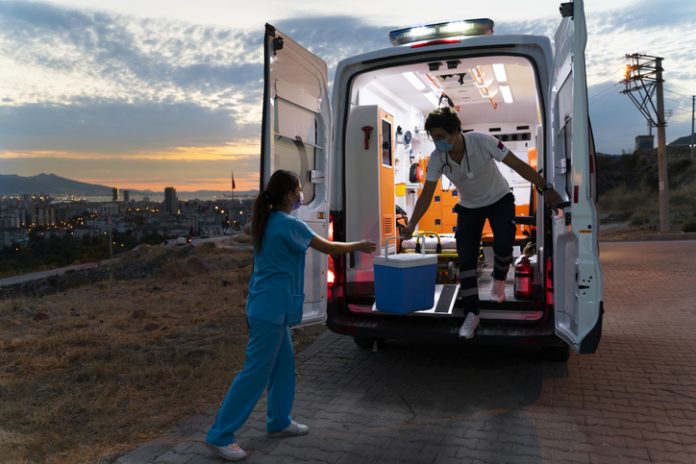Drones, better organ tracking services, and advances that lengthen the viability of donated organs are three developments that have put the United States on a faster track for organ transplants, according to the nation’s network of organ procurement organizations.
Organ transplants are expected to exceed 40,000 in 2021, an 11 percent increase over the previous year, and could reach 50,000 by 2026, says Jan Finn, R.N., president of the Association of Organ Procurement Organizations (AOPO) and president and CEO of the Midwest Transplant Network.
“We are excited that our members are positioned to exceed transplant goals, thanks in part to new and innovative technology and processes,” said Finn in a statement.
Organ Procurement System
The structure of organ procurement organizations was developed under the 1984 National Organ Donation Transplantation Act and seems to be working as intended, Finn told Health Care News.
“It [the Act] set up a system in a really regulatory framework that allows us to have organ procurement organizations, which are compelled to comply with the conditions of participation from CMS [Centers for Medicare and Medicaid Services], and that is the regulatory system for hospitals as well,” said Finn. “So, I really believe the United States has the best system.”
There are 57 OPOs in the United States. All OPOs are non-profits and operate under contracts with the Department of Health and Human Services.
Drones Transporting Organs
Local OPOs are working with companies that provide unmanned aircraft drones to get organs to patients faster, particularly in big cities where traffic can be a big impediment, says Finn.
“When an organ is a thoracic organ, say the heart or the lungs, those transplant teams actually come to the donor hospital to recover the organ and take it back to them, to their center,” said Finn. “But in the case of kidneys and maybe livers as well or pancreas, we could transport them in this manner. Distance is definitely a factor. We’re not going to be sending an organ from Kansas City, Missouri to Phoenix via drone. But maybe it could go to another center in town in an effective manner. So, it’s exciting.”
OPOs are also automating donor identification and referrals for quicker matches and using organ cryopreservation technology which “is revolutionizing how organs are stored, shipped and used in surgeries,” states AOPO.
‘Room for Improvement’
CMS has funded an effort to share best procurement practices between OPOs, donor hospitals, and transplant centers that is expected to reduce the number of “discarded” kidneys from deceased donors by 15 percent.
But despite the increase in the availability of organs, 17 people die each day waiting for an organ, according to the U.S. Department of Health and Human Services’ Health Resources and Services Administration. This represents an increase in deaths among potential organ recipients, says Abe Sutton, a policy advisor to former HHS Secretary Alex Azar and co-founder of Evergreen Nephrology, an organization that partners with nephrologists to support patients with chronic kidney disease.
“The current increase appears to be driven by higher deaths due to the opioid epidemic,” said Sutton. “There is still substantial room for improvement, looking at organs procured per eligible deaths,” said Hutton. “The new transparent metrics are a step in the right direction and more needs to be done. The government should accelerate implementation of the new metrics, and nephrologists should be empowered to help their patients obtain transplants.”
Incomplete Picture
The data currently being collected doesn’t reveal all the inefficiencies in the system, says David Weill, M.D., a principal and founder of the Weill Consulting Group and former director of the Center for Advanced Lung Diseases and the Lung and Heart-Lung Transplant Program at Stanford University Medical Center.
“The numbers don’t provide a complete picture if all we know is the number of transplants is up,” said Weill. “That’s fine to say as a marketing statement but says nothing of how well potential donor organs are being utilized.”
“I think because of the scrutiny, OPOs have reacted but they’re still not getting to the central issue and that is what is the utilization rate of all potential donors out there and how can we continue to draw that number up,” said Weill.
‘They Don’t Have Any Competition’
Weill says the breakdown in the distribution chain is two-fold. “The OPOs haven’t been measured, traditionally, on any metric at all,” said Weill. “It’s a no-bid contract that they have. Probably the best deal going.
“They run their businesses like they don’t have any competition. And no one has asked them to provide data until recently.”
In 2019, the Trump administration finalized new rules designed to increase organ transplants. More than 110,000 patients are on organ waiting lists, but up to 28,000 organs go unrecovered according to a report by The Bridgespan Group. The Trump administration proposed holding OPOs to stricter reporting standards and ranking them according to performance.
AnneMarie Schieber (amschieber@heartland.org) is the managing editor of Health Care News.




















